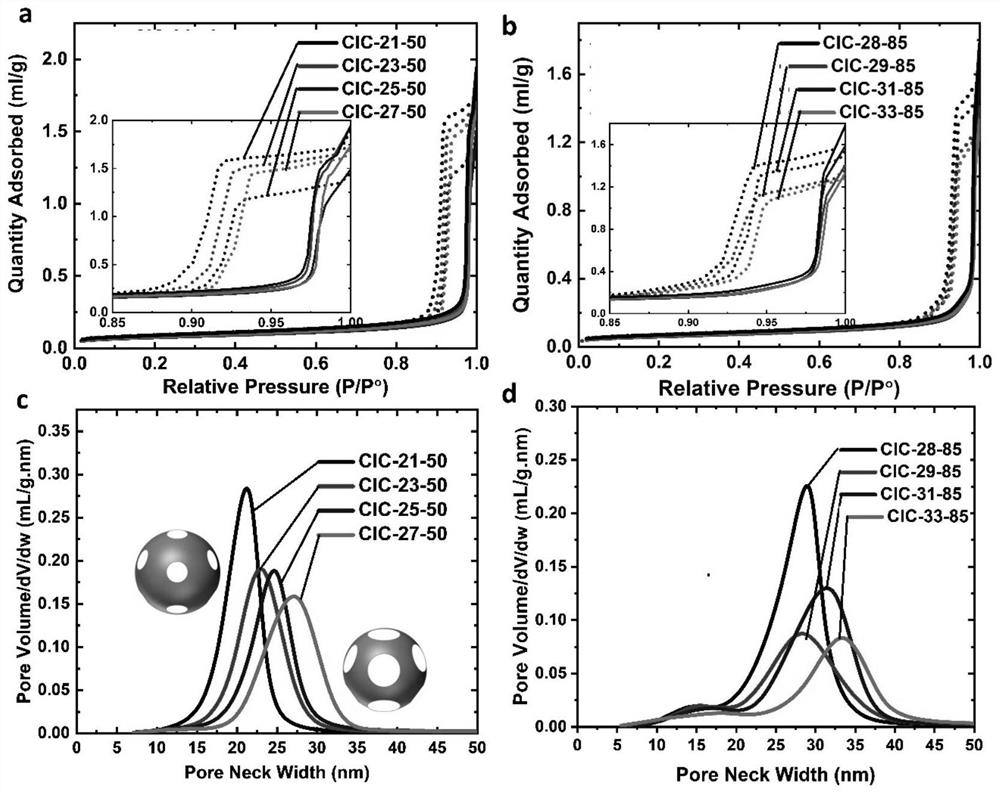Colloidal imprinted carbon CICs with adjustable pore throat size as well as synthesis method and application of colloidal imprinted carbon CICs
A synthesis method, CIC-X-Y technology, applied in the field of new porous carbon materials, to achieve good consistency
- Summary
- Abstract
- Description
- Claims
- Application Information
AI Technical Summary
Problems solved by technology
Method used
Image
Examples
Embodiment 1
[0041] The specific technological process of the present embodiment is as follows:
[0042] S1, drying and grinding the silica sol with a particle size of 50nm to obtain silicon powder, and continuing to dry;
[0043] S2, adding the ethanol solution to the dry silica powder, stirring evenly to obtain the first mixture;
[0044] S3, drying the first mixture at 50° C., exposing it to air for a period of time after cooling, using water vapor in the air to hydrolyze TEOS, and then drying again to obtain silicon powder;
[0045] S4, mixing the dried silicon powder with the carbon precursor (mesophase pitch MP) to obtain a second mixture;
[0046] S5. Under a protective nitrogen atmosphere, heat-treat the second mixture at 300°C for 2 hours, cool to room temperature, and then gradually raise the temperature to 800°C for carbonization treatment for 4 hours, with a heating rate of 5°C / min;
[0047] S6, the solid product was refluxed in 3M NaOH solution for 24h to remove SiO 2 Templ...
Embodiment 2
[0050] The specific technological process of the present embodiment is as follows:
[0051]S1, drying and grinding the silica sol with a particle size of 50nm to obtain silicon powder, and continuing to dry;
[0052] S2. Add the ethanol dispersion solution of ethyl orthosilicate to the dry silica powder, and stir evenly to obtain the first mixture, wherein the mass concentration of ethyl orthosilicate is 4.96wt.%.
[0053] S3, drying the first mixture at 80° C., exposing it to air for a period of time after cooling, using water vapor in the air to hydrolyze TEOS, and then drying again to obtain silicon powder;
[0054] S4, mixing the dried silicon powder with the carbon precursor (mesophase pitch MP) to obtain a second mixture;
[0055] S5. Under the protective atmosphere of nitrogen, heat-treat the second mixture at 400°C for 2 hours, cool to room temperature, and then gradually raise the temperature to 900°C for carbonization treatment for 2 hours, with a heating rate of 5°...
Embodiment 3
[0059] The specific technological process of the present embodiment is as follows:
[0060] S1, drying and grinding the silica sol with a particle size of 50nm to obtain silicon powder, and continuing to dry;
[0061] S2. Add the ethanol dispersion solution of ethyl orthosilicate to the dry silica powder, and stir evenly to obtain the first mixture, wherein the mass concentration of ethyl orthosilicate is 8.67wt.%.
[0062] S3, drying the first mixture at 60° C., exposing it to air for a period of time after cooling, using water vapor in the air to hydrolyze TEOS, and then drying again to obtain silicon powder;
[0063] S4, mixing the dried silicon powder with the carbon precursor (mesophase pitch MP) to obtain a second mixture;
[0064] S5. Under a protective nitrogen atmosphere, heat the second mixture at 500°C for 5 hours, cool to room temperature, and then gradually heat up to 1200°C for carbonization treatment for 3 hours, with a heating rate of 5°C / min;
[0065] S6, th...
PUM
| Property | Measurement | Unit |
|---|---|---|
| particle diameter | aaaaa | aaaaa |
| particle diameter | aaaaa | aaaaa |
Abstract
Description
Claims
Application Information
 Login to View More
Login to View More - R&D Engineer
- R&D Manager
- IP Professional
- Industry Leading Data Capabilities
- Powerful AI technology
- Patent DNA Extraction
Browse by: Latest US Patents, China's latest patents, Technical Efficacy Thesaurus, Application Domain, Technology Topic, Popular Technical Reports.
© 2024 PatSnap. All rights reserved.Legal|Privacy policy|Modern Slavery Act Transparency Statement|Sitemap|About US| Contact US: help@patsnap.com










